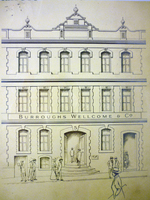Items
Site
The Medicine Chest
keywords is exactly
drawing
-

BWC Cape Town premises (drawing)
Line drawing of the Burroughs Wellcome & Co. office, Cape Town, South Africa. -

Eugen Ransonnet-Villez
"Measuring three feet high by two and half wide and deep, this submersible, of sheet iron and inch-thick glass, had the user's legs sticking out of the bottom so that he could propel himself along the seabed at a depth of five meters or so. It was weighed down by cannonballs, and with air pumped in, the diving bell allowed him to descend for sessions of up to three hours" (The Public Domain Review 2021). -

Lithograph of underwater scene
Lithograph of underwater scene by Eugen Ransonnet-Villez, from colour pencil drawings made by the artist while submerged in his diving bell, from his 'Sketches of the Inhabitants, Animal Life and Vegetation in the Lowlands and High Mountains of Ceylon' (1867) -

Unconquerable Spirit: George Stow and the landscapes of the San
In 2008, the exhibition 'Unconquerable Spirit: George Stow and the landscapes of the San' opened at the Iziko Museum of South Africa. Curated by Pippa Skotnes, the exhibition featured the work of a relatively unknown figure in 19th century South African history. George William Stow was a British born, South African geologist, ethnologist, poet, historian, artist, cartographer, and writer who was responsible for a creating large collection of watercolours and drawings that documented the rock art he found in the caves and shelters of South Africa. The exhibition brought together a vast range of materials representing Stow’s life and the period in which it was produced – from his drawings and paintings; his letters, documents, and poems; to his maps, and field diaries. The display shows one map in particular which is kept as part of the National Library of South Africa collections, and was drawn by Stow during the period he was conducting geological surveys of the country surrounding the diamond fields of Kimberley, down to the junction of the Orange and Vaal rivers and beyond. It shows amongst other things, the diamondiferous deposits of the Vaal river during the late 19th century and, as part of this section of the exhibition which focused on Stow the geologist, Skotnes displayed it alongside relevant disciplinary materials she sourced from the Department of Geological Sciences, University of Cape Town. -

Devils Bridge sketched by Lister
'Devils Bridge' sketched by Lister on his travels through Europe showing a bridge crossing the Gotthard Pass, northern approach, Switzerland. The term 'devil's bridge' is applied to many ancient bridges found primarily in Europe. These were stone or masonry arch bridges and, because they represented a significant technological achievement in ancient architecture, were objects of fascination and stories. The most popular of these featured the Devil, either as the builder of the bridge (relating to the precariousness or impossibility of such a bridge to last or exist in the first place) or as a pact-maker (sharing the necessary knowledge to build the bridge, usually in exchange for the communities souls). The legend attached to the bridge sketched by Lister is of the latter, and was related by Johann Jakob Scheuchzer in 1716. According to Scheuchzer, the people of Uri recruited the Devil for the difficult task of building the bridge. In return for his expertise, the Devil requested the soul of the first thing to pass the bridge. To trick the Devil, the people of Uri sent across a dog by throwing a piece of bread, and the dog was promptly torn to pieces by the Devil. Reference: Scheuchzer, J. , 1747 [1716]. Naturgeschichte des Schweitzerlandes. Vol. 2: 94. -

Breath of a Physicist
William Blake, 1794, Ancient of Days Inscription: "In his hand, he took the Golden Compasses, prepared in Gods Eternal stone, to circumscribe This Universe, and all created things One foot he center'd, and the other turn'd Round through the vast profundity obscure, And said, thus farr extend, thus far thy bounds, This be thy just circumference, O World" "In the process of realising this work, [Cornelia] Parker facilitated the collaboration of scientists from the physics department with those from its art gallery. She also drew attention to the scientific qualities of the artwork and, through the performative act of igniting a firework display, the symbolism of scientific discovery" (Liebenberg 2021: 31). -

Graphene
"Parker formulated 'Breath of a physicist' while engaging with the academic communities of the University of Manchester in 2015. She worked closely with the scientists of the institution, most notably Kostya Novoselov, who, with Andre Geim, was awarded the Nobel Prize for the discovery of graphene – the world’s thinnest and strongest material. After being inspired by the discovery of a graphite drawing by William Blake ('The ancient of days') in the university’s art collection, Parker facilitated a collaboration between the gallery staff and Novoselov in which he sourced microscopic samples of graphite from the drawing, as well as graphite from drawings by Turner, Constable and Picasso and from a pencil-written letter by Sir Ernest Rutherford (who split the atom in Manchester), which all formed part of the university’s collections. Novoselov produced graphene from these samples, which Parker then used to make her own artwork and a ‘Blake-graphene sensor’, which was activated by the breath of a physicist (Novoselov) and set off a firework display, returning iron meteorite into the Manchester sky on the opening night" (Liebenberg 2021: 31).


